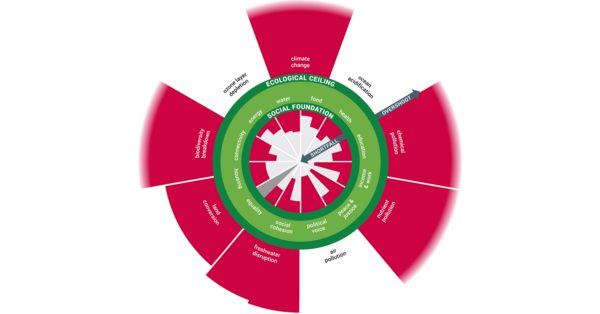The Doughnut framework, which offers a great visual of a sustainable economic model, has recently been updated and refined.


Photo credit: Doughnut Economics Action Lab
Doughnut 3.0
The Doughnut Economics Action Lab has released an update to its doughnut-shaped framework of social and planetary boundaries, as well as a slew of resources to help explain the concept.
In a nutshell, the doughnut concept is an economic model that “meet the needs of all people within the means of the living planet”, where economic activity is bounded by two concentric rings: a social foundation, to ensure that no one is left falling short on life’s essentials, and an ecological ceiling, to ensure that humanity does not destabilise the life-supporting systems that sustain all life on Earth.
The 2025 iteration of the Doughnut makes three core changes: (i) dimensions and indicators have been updated; (ii) outcomes from 2000 to 2022 are tracked and will keep updating annually; and (iii) results are disaggregated into three country-clusters (poorest-40%, middle-40%, and richest-20%).
The Evolving Doughnut Report will tell you more about the inspiration for the framework and how and why it has evolved over its first three iterations. This webpage also offers interactive access to the indicators and data used.
But this framework is more than theoretical. In a study published in the scientific journal Nature, the authors analyse trends across 35 indicators from 2000 to 2022 and across the three country clusters to provide an assessment of the progress towards the goal of meeting the needs of all people within the means of the planet:
“Although global gross domestic product (GDP) has more than doubled, our median results show a modest achievement in reducing human deprivation that would have to accelerate fivefold to meet the needs of all people by 2030. Meanwhile, the increase in ecological overshoot would have to stop immediately and accelerate nearly two times faster towards planetary boundaries to safeguard Earth-system stability by 2050. Disaggregating these global findings shows that the richest 20% of nations, with 15% of the global population, contribute more than 40% of annual ecological overshoot, whereas the poorest 40% of countries, with 42% of the global population, experience more than 60% of the social shortfall. These trends and inequalities reaffirm the case for overcoming the dependence of nations on perpetual GDP growth and reorienting towards regenerative and distributive economic activity—within and between nations—that assigns priority to human needs and planetary integrity.”
Doughnut of social and planetary boundaries monitors a world out of balance
Kate Raworth is a classically trained economist who has become a vocal critic of the flawed (and now largely debunked) assumptions underpinning classical economic theory and a leading global voice for 21st-century economic thinking.
The Doughnut framework offers a mindset nudge towards alternative models of human activity. Associated with the broader degrowth (where “de”=“away from”) movement, it illustrates the steady-state model to settle into after a period of recalibrating our global production/consumption (where some countries reduce but others increase their production and consumption) to fall back within planetary boundaries, while maintaining wellbeing conditions for all humans, not just some of them.
The trick is now to envision how this translates into corporate strategy and business models.
Published by
 ESG Disclosure Coach
ESG Disclosure Coach
 ESG Disclosure Coach
ESG Disclosure Coach

